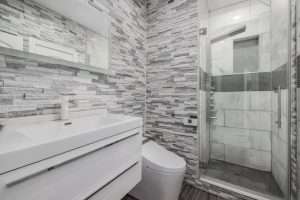Introduction
Designing a home theater can seem daunting, but with the right guidance, it can be a rewarding experience. This article will show you how to design a home theater from start to finish.
Quick Steps to Design Your Home Theater:
- Pick the right room: Choose a space with little natural light.
- Plan for acoustics: Invest in soundproofing and quality speakers.
- Select your equipment: Choose the right projector, screen, and sound system.
- Consider your seating arrangement: Plan for optimal viewing.
- Add lighting and décor: Create an immersive atmosphere.
Creating a home theater isn’t just about placing a projector and some seats in a room. It’s about crafting an immersive environment where the magic of movies comes to life. From soundproofing to equipment choices, every decision plays a crucial role in building the ideal entertainment space.
Hi, I’m Bob Berriz. With over 30 years of experience custom-designing luxury home spaces, I understand what it takes to create a state-of-the-art home theater. My aim is to share tips on how to design a home theater that meets your high standards and exceeds your expectations.

Berriz Desing - Unique Design &Build Remodeling Services
Planning Your Home Theater
Location
Choosing the right location is the first step in how to design a home theater. Ideally, you’ll want a space that’s relatively isolated from the rest of the house. This helps in minimizing disturbances and controlling ambient sounds and light.
A good option includes:
- Building a theater wing off the family room
- Closing in the open second-story space above a formal living room
- Converting a spare bedroom that’s at least 12 by 12 feet
Dedicated Space
A dedicated home theater space ensures that the room is used primarily for watching movies, shows, and gaming. This focus helps in creating an immersive experience, free from the distractions that come with shared spaces.
When the home theater shares space with other activities, the cinematic experience is compromised. For instance, if your theater is in the living room, light control and noise become significant issues. A dedicated space helps in controlling these variables more effectively.
Designing for Optimal Viewing and Sound
Sight Lines
Ensuring clear sight lines is crucial for a great viewing experience. All seats should have an unobstructed view of the screen. To achieve this:
- Measure the distance from each seat to the screen. Use the 1.5 to 2.5 times the screen width rule for optimal viewing distance.
- Elevate seating if you have multiple rows. This prevents heads from blocking the view.
Riser Construction
Building a riser can improve sight lines for multi-row seating:
- Height: Standard risers are 12-18 inches high. Adjust based on the height of your seats and the screen.
- Steps: Add a step if the riser is higher than 12 inches to make it easier to access.
- Consider ceiling height: Ensure guests can stand comfortably on the riser without hitting the ceiling.
Screen Height
Proper screen height enhances comfort and viewing quality:
- Bottom third rule: Position the bottom third of the screen at least 48 inches off the ground. This keeps the screen at eye level for most viewers.
- Adjust for risers: If using risers, ensure the screen is high enough for viewers in the back row.
Selecting the Right Equipment
Choosing the right equipment is crucial for a top-notch home theater experience. Let’s break down the essentials:
Projector vs. Flat Screen
Projector:
- Size Matters: Projectors can create images as large as 150 inches, making them ideal for a true cinema feel.
- Cost-Effective: Full HD projectors start around $600, offering great value for large screens.
- Brightness: Aim for at least 2,000 lumens for dark rooms and 3,000 lumens for rooms with some light.
- Flexibility: Look for zoom and lens shift features to easily adjust the image size and position.
Flat Screen:
- Ultra HD 4K: Offers stunning clarity and detail, enhancing the viewing experience.
- Smart Features: Many flat screens come with built-in apps, making streaming easy.
- Size Range: Ideal for smaller rooms where a projector might be overwhelming.
A/V Component Rack
A well-organized A/V component rack is essential:
- Ventilation: Components generate heat. Use open-air racks to prevent overheating.
- Sturdiness: Ensure the rack can support all your devices.
- Accessibility: Keep the front and back open for easy access to cables and controls.
Ventilation
Proper ventilation is key to maintaining your equipment:
- Open-Air Racks: Metal racks with open fronts, backs, and sides promote airflow.
- DIY Options: Build your own rack using a metal grid as the platform to enhance ventilation.
- Avoid Overheating: Excessive heat can damage your electronics, so ensure good airflow.
Enhancing Your Home Theater Experience
Lighting System
Proper lighting can make or break your home theater experience. Dimmable LED lights are a must-have as they let you control the brightness to match the mood of your movie. You can also use accent lighting such as floor or table lamps to add depth without overwhelming the room.
Blackout curtains are essential to block out any external light, ensuring that your screen remains the focal point. This is especially important if your home theater is not in a basement or a room with no windows.
Acoustic Treatment
Sound quality is crucial for an immersive experience. Here are some quick tips:
- Wall-to-wall carpeting: This reduces audio bounce and creates a quieter room.
- Draperies and soft materials: Install these on the walls to further absorb sound.
- Soft seating: Choose cushiony seating over hard furniture to minimize sound reflections.
- Acoustic panels: These can be custom printed with designs or family photos to serve both as sound absorbers and decorative elements.
Reflective Objects
Reflective surfaces can ruin your sound quality. Avoid using picture frames with glass, as they bounce sound waves back into the room. Instead, opt for:
- Non-glass frames for your movie posters.
- Soft furnishings like fabric-covered frames or acoustic panels that double as artwork.
Seating Arrangement
Comfortable seating is key for long movie marathons. Here are some tips:
- Stadium seating: Elevate the back row with a pre-built platform for better viewing angles.
- King’s Chair: Place your favorite seat in the optimal spot, usually in the middle and slightly back from the center.
- Theater-style seats: Look for options with cup holders and armrests. Two rows of four seats fit comfortably in a 20 by 13-foot room.
- Soft, ergonomic seating: Choose recliners or plush sofas for maximum comfort.
By focusing on these elements, you can transform your home theater into a space that rivals a commercial cinema. Next, let’s address common questions about home theater design.
Addressing Common Home Theater Design Questions
How to Create a Home Theater
Creating a home theater involves several key steps. Here’s a simple guide inspired by HGTV to get you started:
-
Choose a Location: The ideal space is around 20 feet long by 13 feet wide and isolated from the rest of the house. Think about converting a spare bedroom or closing in an open space.
-
Frame and Insulate: Build the shell of your home theater with special attention to insulation. Use R30 for floors, ceilings, and exterior walls, and R11 for interior walls to keep the sound contained.
-
Pre-Wire Surround Sound: Most home theaters use a 7.1 surround sound system. Mark speaker locations and run audio cables from your equipment hub to each speaker spot. Cables should be at least 16-gauge for side and rear speakers, and stronger for the front ones.
-
Pre-Wire a Video Projector: Use an HDMI cable for high-definition video and a CAT5 control wire for remote access. Extend these from the ceiling at the rear of the theater to your equipment hub.
-
Pre-Wire Lighting: Install recessed ceiling lights and sconces on the side walls. Connect them to an RF dimmer for easy control.
-
Install Drywall and Sound Barriers: Use specialty drywall like QuietRock or ordinary drywall lined with sound-dampening materials. Hang a solid-core door for better sound reduction.
-
Set Up Video and Sound Systems: Hang your speakers, projector, and screen once the drywall is painted. A 110-120 inch screen works well for a 20 by 13-foot room.
-
Install Theater-Style Seating: Authentic theater seats with cup holders and armrests add a professional touch. Elevate the back row with a platform for better viewing.
What is the Golden Ratio for Home Theater?
When designing a home theater, the room’s dimensions can significantly impact the audio and visual experience. The commonly recommended ratio is 1:1.28:1.54 for height, width, and length, respectively.
For example:
- Height: 10-12 feet
- Width: 15-20 feet
- Length: 20-25 feet
This ratio helps in achieving optimal sound dispersion and viewing angles. However, it’s not set in stone. Modern acoustic treatments and room correction technologies can help you get great results even in non-ideal spaces.
Standards for Home Theater Design
Room Shape and Size: A rectangular room is ideal for a home theater. It helps in better sound distribution and easier equipment placement. A room that is at least 15 feet wide and 20 feet long is recommended for a more immersive experience.
Ceiling Height: Aim for a ceiling that’s at least 7 feet high. This allows you to place the projector screen at an optimal height and improves sound quality.
Seating Layout: Design your seating around the “King’s Chair,” the best seat in the house. Typically, this is in the middle and slightly back from the center.
Screen Placement: The center of the screen should be at eye level when seated. Avoid placing the screen directly opposite windows to minimize glare.
Acoustic Treatment: Use sound-absorbing panels, bass traps, and diffusers to enhance audio quality. Carpeting, draperies, and soft seating materials also help in reducing sound bounce.
By following these guidelines, you can create a home theater that offers both comfort and an immersive cinematic experience. Next, we’ll delve into some inspirational design ideas to help you create your dream cinema.
Conclusion
Final Touches
Now that we’ve covered the essentials of how to design a home theater, let’s talk about the finishing touches that bring everything together.
Decor: Your home theater should reflect your personal style. Consider adding movie posters, acoustic panels with custom designs, or even a themed décor. For example, you might go for a classic cinema look with velvet curtains and vintage movie reels.
Lighting: Proper lighting can make or break your home theater experience. Use dimmable lights and blackout curtains to control ambient light. Smart bulbs can add a touch of convenience, allowing you to adjust the lighting with a voice command or remote control.
Seating: Authentic theater-style seating can elevate your viewing experience. Opt for comfortable recliners or sofas with cup holders. If you have multiple rows, consider using risers to ensure everyone has a clear view of the screen.
Ventilation: Ensure your room is well-ventilated to keep it comfortable. Overheating can ruin the experience, and proper airflow will help maintain the longevity of your equipment.
Berriz Design Build
At Berriz Design Build, we understand that a home theater is more than just a room—it’s an experience. Our team is dedicated to turning your vision into reality. From the initial consultation to the final installation, we ensure every detail is perfect.
We listen to your ideas and offer solutions that fit your lifestyle and budget. Our focus on quality means you get a home theater that not only looks great but also performs exceptionally well.
Ready to start your journey towards the perfect home theater? Contact us today to bring your vision to life.
By incorporating these final touches and partnering with Berriz Design Build, your dream home theater is just a step away. So dim the lights, grab your popcorn, and get ready to be whisked away into your private cinema.





